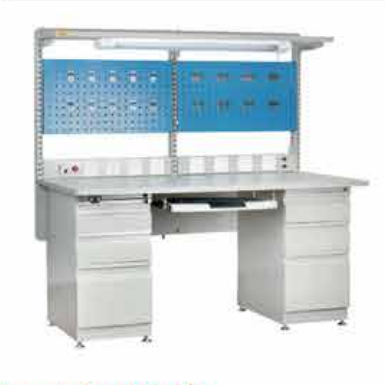The quick-evolving medical device production alongside electronic device manufacturing requires absolute adherence to cleanroom management and Electrostatic Discharge safety implementation. Such modern cutting-edge technology becomes useless through exposure to hidden threats that people often miss. The purpose of ESD workbenches is to protect delicate electronics free of electrostatic discharge so they operate without failure. These static protection platforms offer more than basic safety functions since they help sustain cleanroom operation standards. The purpose of this article is to explain how ESD workbenches protect electronics by explaining the distinction between static dissipation and conductive platforms with emphasis on filter integration in contamination control based on a medical device production scenario.
Static Dissipation vs. Conductive Workstations
Complete understanding of ESD workbench operations starts from learning about the separation between conductive workstations and static dissipation models. The two workstation types differ in their strategy for static electricity control even though they share a common goal.
Static Dissipation Workstations
The static dissipative workstation features construction which lets electric charges discharge at controlled and secure speeds. These surfaces and materials resist electrical charges between 1 x 10^6 to 1 x 10^11 ohms per square. A specific resistivity level between 1 x 10^6 to 1 x 10^11 ohms per square prevents damaging discharges of ESD charge by allowing steady charge dissipation. These materials find applications in manufacturing situations where controlling electrostatic development matters most and the sensitive equipment tolerates controlled but gradual charge movements.
Conductive Workstations
The resistivity value of conductive workstations typically falls between 1 x 10^4 and 1 x 10^6 ohms per square due to their construction materials with low resistivity values. The basic purpose of these workstations consists of instant electrical charge transfer to the ground surface. The conductive properties of these materials eliminate any danger of developing harmful static accumulation therefore they are adequate for workplaces handling delicate electronic parts.
The decision between these types of workstations depends on the unique needs and electronic sensitivity requirements present in cleanroom settings. Electromagnetic Capacitance (EMC) assessments serve as the main method through which companies select the appropriate workstation type.
Filter Integration for Contamination Control
The control of electrostatic discharge should be combined with environmental protection free from contaminants to meet cleanroom standards. The ISO standards establish different categories for cleanrooms that specify maximum particulate contamination limits. ESD workbenches now include sophisticated filtration systems which fulfill ISO standards for contamination control.
Vendor-provided ESD workbenches today often include either HEPA or the improved ULPA filtering systems. These filters are crucial for:
1.Removing Particulate Contamination:
The HEPA filter can reach HEPA performance by trapping 99.97% of particles 0.3 microns in size yet ULPA filter performance enables the trapping of 99.999% of 0.12-micron particles. The filtration efficiency reaches nearly complete levels with these filters which ensures effective follow-up of cleanroom compliance procedures.
2.Maintaining Airflow Dynamics:
The combination of filtration systems works to lower turbulent airflow and maintain a one-way airflow direction which minimizes the chance of particle resuspension. Preventing settlement of contaminants on sensitive parts is only possible through the implementation of this vital control mechanism.
3.Enhancing Worker Safety:
Safety levels at work improve through effective contamination control which protects electronic component handlers from particle-related health disorders.
Case Study: Medical Device Manufacturing
EDS workbenches combined with filtration systems show their significance through the example of a medical device manufacturer that produces implantable cardioverter-defibrillators (ICDs). The ICD devices incorporate special sensitive electronics which need to avoid ESD interference along with contaminant contaminants.
The company observed the following changes after they installed conductive ESD workbenches together with advanced ULPA filters.
Enhanced Product Reliability:
Product reliability increased because the implemented technology rapidly discharged electrostatic buildup and included efficient particulate removal which reduced failure rates of the ICDs.
Improved Cleanroom Compliance:
The combination helped maintain the cleanroom at ISO Class 5 standards which remains crucial for medical device production.
Worker Efficiency and Safety:
The workplace area decision resulted in product safety protection and enhanced worker conditions leading both to improved operational speed and job contentment.
The protection of sensitive electronics in cleanroom settings strongly depends on ESD workbenches which serve as essential protective equipment. Businesses need to know the distinctions between conductive and static dissipation workstations to choose the right methods for their particular needs. These workbenches benefit medical device manufacturing operations by combining advanced filtration systems which ensure free-contaminant environments. The integration of these specifications produces enhanced reliability together with safety attributes as well as compliance to industry norms thereby proving why ESD workbenches remain essential in present-day electronic and medical manufacturing sectors.







